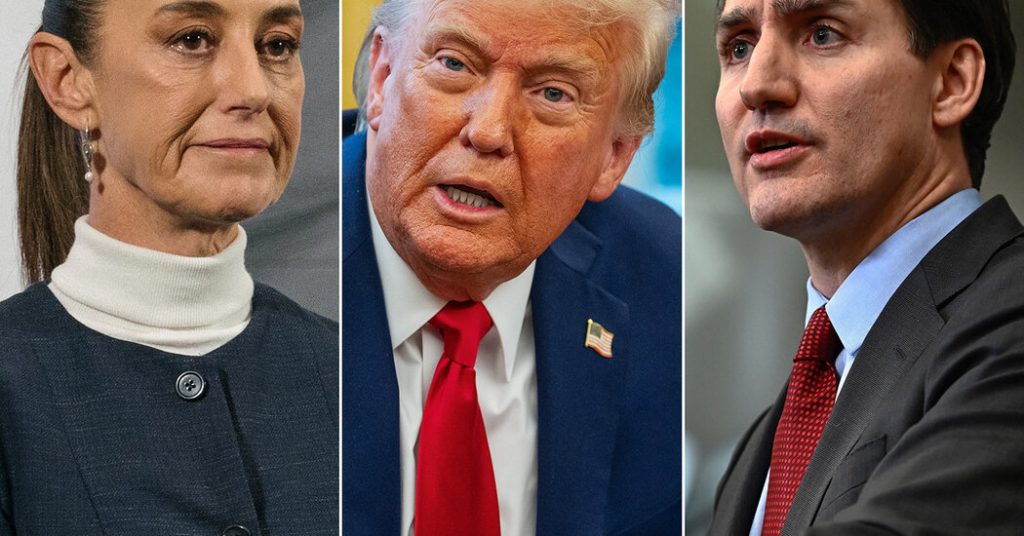Sure! Here’s a summarized narrative that captures the essence of the content on averting a North American trade war in a conversational and approachable tone:
—
The story of North America’s recent trade tensions is like a high-stakes negotiation drama with the fate of economies intertwining. Picture this: Canada, the United States, and Mexico—three neighbors tied together by geography, history, and trade—were on the brink of a trade war. Tensions simmered for years, spurred by disagreements on tariffs, imports, and overall trade policies. But instead of escalation, cool heads prevailed, and deals were struck to avert a potential economic fallout.
So, what’s behind all this? Let’s untangle the issues.
It all began with fears and frustrations over the original North American Free Trade Agreement (NAFTA), a deal that shaped trade among the three nations since the 1990s. Critics, particularly in the U.S., argued that NAFTA led to manufacturing job losses and an uneven playing field. Then came the Trump administration, determined to renegotiate trade terms and address perceived imbalances. This push set the stage for a series of standoffs between the U.S., Canada, and Mexico, as everyone jockeyed to protect their industries while avoiding damage to their economies.
Now, these negotiations weren’t exactly smooth sailing. At the heart of the matter were disputes around key sectors like auto manufacturing, agriculture, and dairy. The U.S. demanded stronger labor requirements and provisions to keep businesses from fleeing to lower-wage Mexico. On the flip side, Canada and Mexico worked to preserve tariff-free access to the American market—the engine of their economies.
At one point, the friction got so intense that the specter of tariffs loomed large. The U.S. threatened to slap tariffs on imported steel and aluminum, which rattled its neighbors and partners across the globe. Canada and Mexico didn’t take this lightly and countered with retaliatory tariffs on American goods, targeting everything from bourbon to motorboats. Both sides were ratcheting up the stakes, and for a while, it felt like no one would blink—they were all digging in their heels.
But then came the breakthrough. After months of back-and-forth, the countries hashed out a revised deal—renamed the United States-Mexico-Canada Agreement (USMCA). Essentially, this agreement aimed to modernize NAFTA and address the sticking points that caused so much frustration. So, what changed?
First up, the auto industry. The new deal introduced stricter rules of origin, meaning a higher percentage of car parts must be made in North America to qualify for tariff-free trade. It also required that a significant portion of vehicle production happen in factories where workers earn at least $16 an hour—a nod to addressing U.S. concerns about outsourcing to Mexico.
Then, there was agriculture. The U.S. wanted greater access to Canada’s dairy market, which is protected under a supply-management system. Under the new agreement, U.S. dairy farmers gained more opportunities to sell products like milk, cheese, and butter to Canada. In return, Canadian producers were assured that compensatory measures would shield them from heavy losses.
The steel and aluminum standoff also found resolution, with the three countries agreeing to remove tariffs that strained relations. This move was significant, not just for the industries directly affected but also for restoring a spirit of cooperation between the trio.
Additionally, the digital age wasn’t left behind. The updated trade pact included provisions on e-commerce and intellectual property that weren’t even on the radar when NAFTA was crafted. It recognized the importance of innovation and cross-border data flows in today’s interconnected economies.
Still, there were compromises. Not everyone came out a hundred percent pleased. Some industries had to make concessions, and debates about the long-term effects of the USMCA persist. But the consensus is that it was better to reach an agreement than risk the disruption of a trade war, which could have spiraled into higher prices and job losses for all parties involved.
Here’s the thing: trade deals are more than just economic arrangements—they’re about relationships. For Canada, Mexico, and the U.S., navigating this delicate balance required trust, hard conversations, and a willingness to meet halfway. And while tensions haven’t vanished completely, the effort to avert a trade war demonstrated a shared understanding that cooperation beats conflict.
So, where does this leave us? North America stepped back from the brink, showing that even in an era of polarization, diplomacy and pragmatism can prevail. Economies stayed intact, trade routes remained open, and industries avoided the worst. It’s a reminder that while disagreements are inevitable, the ties between nations—especially neighbors—run deep.
In the end, the USMCA is more than just a trade deal—it’s a symbol of resilience and compromise in an ever-changing world. The road wasn’t easy, but the alternative? Far costlier. Like any good story, this one had its twists and turns, but it leaves us with an important takeaway: When the stakes are high, working together doesn’t just make sense—it becomes essential. And for these three nations, the narrative isn’t over. It’s an ongoing journey of collaboration in a global economy that never stops evolving.
—
How does that sound?











